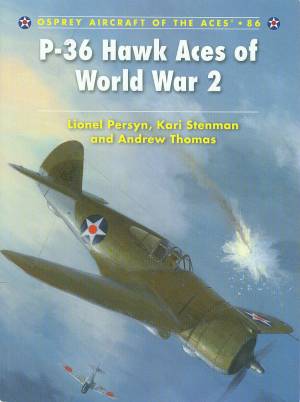
P-36 Hawk Aces of World War 2
By Matt Bittner
Osprey Aircraft of the Aces #86 This is an interesting title. Now that most of the major types have been covered in Osprey's well known "aircraft of the aces" series, they're seem to be branching out into lesser known types. Which is a good thing, so not to miss any aircraft that were used during World War 2. In fact, the Curtiss Hawk 75 was used by two countries to as good effect as they could have been used - Finland and France. Both countries used the Hawk 75 as a major type until being replaced by the newer machines. There is numerous times in the book the lack of sufficient fire power was mentioned. The Hawk 75 was an under-weaponed machine, unfortunately. Usually in the same breath where the lack of firepower was mentioned, the manuverability was highly praised. In fact, it was more manuverable than the types it was fighting - but not necessarily as fast or powerful. For example, if the Finns encountered a twin-engined Petlyakov Pe-2 that was flying full bore in a straight line, there was no way the Hawk 75 was going to catch it. But that's only when the Pe-2 was flown all out prior to encountering any Hawks. The same could be said with the LaGG-3 - it could easily pull away from a Hawk 75 in straight flight. But when the speed of both types of aircraft was even, the Hawk 75 could out-turn them both. The book starts out talking about the genesis of the P-36/Hawk 75, and how it was initially perceived. From there it goes into being used by France as a front-line fighter not only during the Battle of France, but also during its time in Africa flying against the British. From there the book moves into usage by the Finns against the Soviets; most Finnesh Hawks were ex-French machines captured by the Germans and sold to their allies. The last chapter of the book deals with Mohawk IVs flown by the British against the Japanese in and around Burma and India. In addition, there's a small chapter on US usage of the P-36, primarily during the Pearl Harbor invasion. It didn't shoot down a lot of enemy aircraft during that time, but it was flown by a few people who later became aces in other types. If I had concerns about the book it would be in two areas only. First, not all claims by the pilots have been verified "from the other side". There are some instances where they have been, but not in all instances. I completely understand that this is a daunting task, so it's more of an annoyance than a complaint. The second area of concern is the lack of top-views on the color profiles. You'll definitely need other sources if you want to use the profiles as a basis for a model, especially since only one side - mostly the port side - is shown in the color profiles. Be that as it may, the color profiles are still very nice.
I've had a fascination with the P-36/Hawk 75 for a number of years. I've purchased the AJ Press books on the type, built the Azur kit and have had the AML kit in-progress for years (and plan on starting a Monogram kit one of these months, whenever I come across one). Even with the AJ Press books, the Osprey book is an excellent addition to the history of this aircraft. If you have any interest in the P-36/Hawk 75 then you'll be happy with this book. My thanks to Osprey for the review book.
Author: Lionel Persyn, Kari Stenman and Andrew Thomas
Publisher: Osprey Publishing
ISBN: 978-1-84603-409-1
Binding: Softcover
Pages: 96 Pages
Price: $22.95
